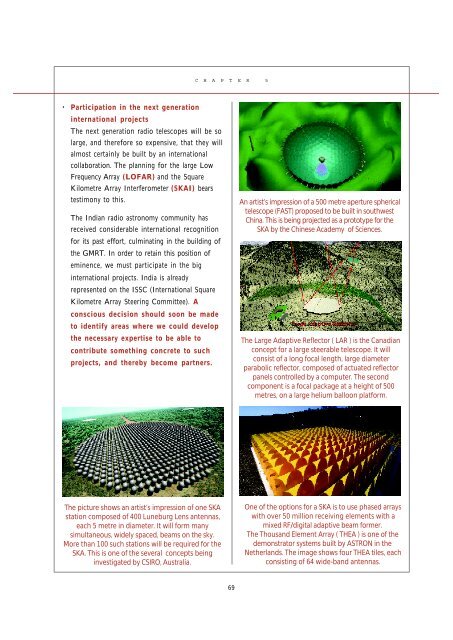2004 ASTRONOMY & ASTROPHYSICS - Indian Academy of Sciences
2004 ASTRONOMY & ASTROPHYSICS - Indian Academy of Sciences
2004 ASTRONOMY & ASTROPHYSICS - Indian Academy of Sciences
You also want an ePaper? Increase the reach of your titles
YUMPU automatically turns print PDFs into web optimized ePapers that Google loves.
CHAPTER 5<br />
• Participation in the next generation<br />
international projects<br />
The next generation radio telescopes will be so<br />
large, and therefore so expensive, that they will<br />
almost certainly be built by an international<br />
collaboration. The planning for the large Low<br />
Frequency Array (LOFAR) and the Square<br />
Kilometre Array Interferometer (SKAI) bears<br />
testimony to this.<br />
The <strong>Indian</strong> radio astronomy community has<br />
received considerable international recognition<br />
for its past effort, culminating in the building <strong>of</strong><br />
the GMRT. In order to retain this position <strong>of</strong><br />
eminence, we must participate in the big<br />
international projects. India is already<br />
represented on the ISSC (International Square<br />
Kilometre Array Steering Committee). A<br />
conscious decision should soon be made<br />
to identify areas where we could develop<br />
the necessary expertise to be able to<br />
contribute something concrete to such<br />
projects, and thereby become partners.<br />
An artist’s impression <strong>of</strong> a 500 metre aperture spherical<br />
telescope (FAST) proposed to be built in southwest<br />
China. This is being projected as a prototype for the<br />
SKA by the Chinese <strong>Academy</strong> <strong>of</strong> <strong>Sciences</strong>.<br />
The Large Adaptive Reflector ( LAR ) is the Canadian<br />
concept for a large steerable telescope. It will<br />
consist <strong>of</strong> a long focal length, large diameter<br />
parabolic reflector, composed <strong>of</strong> actuated reflector<br />
panels controlled by a computer. The second<br />
component is a focal package at a height <strong>of</strong> 500<br />
metres, on a large helium balloon platform.<br />
The picture shows an artist’s impression <strong>of</strong> one SKA<br />
station composed <strong>of</strong> 400 Luneburg Lens antennas,<br />
each 5 metre in diameter. It will form many<br />
simultaneous, widely spaced, beams on the sky.<br />
More than 100 such stations will be required for the<br />
SKA. This is one <strong>of</strong> the several concepts being<br />
investigated by CSIRO, Australia.<br />
One <strong>of</strong> the options for a SKA is to use phased arrays<br />
with over 50 million receiving elements with a<br />
mixed RF/digital adaptive beam former.<br />
The Thousand Element Array ( THEA ) is one <strong>of</strong> the<br />
demonstrator systems built by ASTRON in the<br />
Netherlands. The image shows four THEA tiles, each<br />
consisting <strong>of</strong> 64 wide-band antennas.<br />
69
















